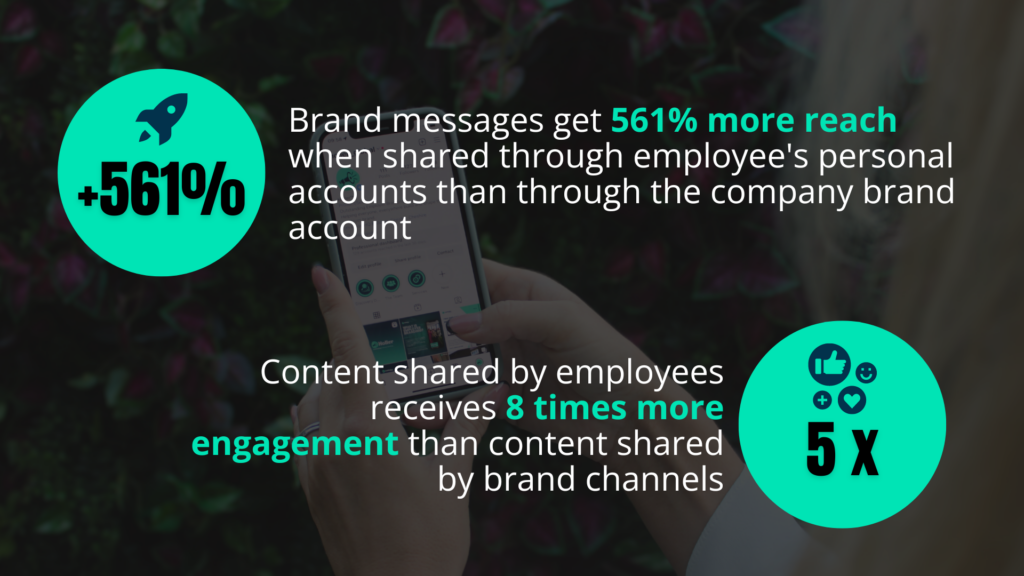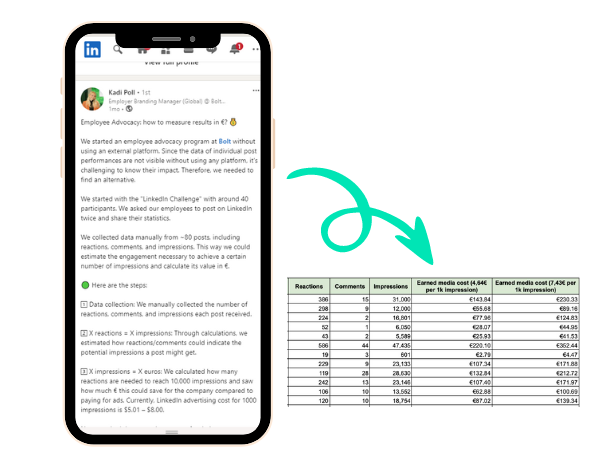Once you’ve completed your discovery process, shaped the employer brand architecture, activated the employer brand across the candidate and employee experience, and brought this to life through your careers site and social pages, it’s time to look at employee advocacy activation. Employee advocacy refers to the act of an employee “promoting” your business, and in this blog we are looking at this specifically in relation to promoting your organisation as a great place to work across social media.
There are lots of reasons why employee advocacy is a powerful tool for employer brand promotion, but we have boiled this down to a couple of our favourite statistics:
Brand messages get 561% more reach when shared through employee’s personal accounts than through the company brand account.
Content shared by employees receives 8 times more engagement than content shared by brand channels.
We always preach about employee advocacy to clients because the networks of existing employees can be super relevant for your target candidate demographics. Your employees are connected with likeminded people, people who live locally to them (and most likely your offices), people they worked with in previous companies (with similar skillsets / background), people they studied together with at university etc. People who will trust your employees’ opinions, when they share posts that highlight why they enjoy working for you, much more than they would reading a job advert shared by a brand they aren’t familiar with. Here are 6 things to consider when launching your employee advocacy programme.

Focus on the experience
While adopting a formal employee advocacy programme can help to maximise the impact of employer brand reach and engagement, unless you truly invest into your employee experience you will never reap the benefits of this. Employees will not fly the flag for your organisation as a great place to work unless it is the truth, so you MUST invest into shaping and enhancing your employee experience as part of your employer brand strategy. This means listening to employee feedback, acting on areas that you need to improve in, and providing moments of delight across the employee experience / culture touchpoints. To put it simply, give employees something good to shout about!
Create a hashtag
Create a relevant hashtag that’s easy to remember and encourage employees to use this when sharing content. For example our parent brand Searchability uses #SearchabilityLife for all employer brand content. It’s easy to remember, it’s unlikely to be used by people outside of the organisation and it allows us to collate all employee generated content easily.
Empower your brand champions
When assembling your employer brand team you should have pinpointed some employer brand champions to help you with the activation stage. This is the time to get them on board! When we partner with a company we use this stage to host an employee advocacy workshop to showcase best practice, help create ideas for content generation and create excitement around employee advocacy adoption with our social and content experts.

Collate employee generated content
Polished employer brand content is great, but we are huge fans of simple and honest employee generated content at Holler! Make sure you collate content shared using your employer brand hashtag to use in the future (and get your employees’ permission to share).
Re-share from your brand channels
If your employees tag you in a post that showcases your employer brand, culture, environment, and overall employee experience then be sure to share this to your main pages to help increase reach and diversify your content.
Consider gamification and measure success
In some instances, you might see success by gamifying the employee advocacy process. This can be controversial as you obviously don’t want to be forcing people to share nice things about you solely for the chance of winning a prize, but the prospect of an incentive can definitely help encourage people to get involved. This is particularly useful as you launch your employer brand externally, as it can take a while for the act of sharing / using your hashtag to become habitual. You can also look to measure success from the advocacy as part of metrics tracking, which can be really useful to secure budget for employee advocacy gamification and investment into employee experience too. Kadi Poll, Employer Brand Manager at Bolt recently shared her approach to this on LinkedIn, collating data collected from posts and calculating the perceived saving in advertising spend as a result. Her approach was not to gamify, but to champion this as a way to help employees build a personal brand, whilst of course advocating for Bolt too. Worth a look for anyone looking to get started with tracking the ROI of employee advocacy for their brand.

So there you have it, our top tips for launching an employee advocacy programme! If you are keen to explore employee advocacy for your organisation, and want to get started with an employee workshop check out our services here or get in touch to book your session in!



